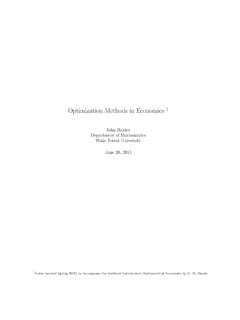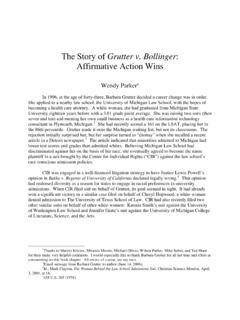Transcription of The Cobb–Douglas Production Function
1 Economics 207, 2019 Allin Cottrell The cobb douglas Production Function 1 Introduction In general, a Production Function is a specification of how the quantity of output behaves as a func- tion of the inputs used in Production . This concept can be applied at the level of individual firms, industries, or entire economies. Since we're doing macroeconomics we will be considering an ag- gregate Production Function , applying at the economy-wide level. Various specific mathematical forms have been put forward for the Production Function , but the most commonly used is that developed by Charles cobb and Paul douglas in the second quarter of the 20th century. Here's their specification: Y = AK N 1 0< <1 (1). Here Y represents aggregate output, K the capital input, and N the labor input (capital and labor being the two factors of Production in this Function ). The A term represents Total Factor Produc- tivity (TFP for short); you can think of this as a quality factor as opposed to K and N which are just quantitative.
2 The value of A reflects the state of technology as well as the skill and education level of the workforce. All being well, we'd expect A to be gradually increasing over time. 2 Marginal product, diminishing returns A particularly important aspect of a Production Function is the marginal product of the factors. Take first the marginal product of labor (or MPN for short) that is, the change in output that results when the labor input is varied, holding the capital input and TFP constant. We find this by taking the first derivative of equation (1) with respect to N: dY. MPN = = (1 )AK N 1 1 (2a). dN. = (1 ) AK N 1 N 1.. (2b). Y. = (1 ) > 0 (2c). N. Given that Y and N must be positive and is a positive fraction, we see that the marginal product of labor must be positive: a greater labor input leads to the Production of more output. No suprise there. The familiar economic concept of diminishing returns leads us to expect that the MPN, while positive, should be declining: as the labor input is increased, holding K and TFP constant, output should increase but at a diminishing rate.
3 Does the cobb douglas Function satisfy this condition? To find out we need to take the derivative of the MPN with respect to N, or in other words the 1. second derivative of Y with respect to N. dMPN d 2Y. = = ( )(1 )AK N 1 2. dN d N2. = ( )(1 ) AK N 1 N 2.. Y. = ( )(1 ) 2 < 0. N. We can tell that the second derivative is negative hence satisfying diminishing returns because all terms in the multiplicative expression are positive apart from the negative . Strictly analogous math tells us that the cobb douglas Function also exhibits a positive but dimin- ishing marginal product of capital, MPK. (In this case the thought-experiment is, what happens to output when K is increased while N and TFP are held constant?). Positive MPK: dY. = AK 1 N 1 = AK N 1 K 1.. MPK = (3a). dK. Y. = >0 (3b). K. Diminishing returns to capital: dMPK d 2Y. = = ( 1) AK 2 N 1 . dK dK2. Y. = ( 1) 2 < 0. K. 3 Cross partials A further point relevant for macroeconomic analysis: what (if anything) happens to the marginal product of labor when the capital input is increased?
4 And conversely, what happens to the MPK. when N increases? In mathematical terms, we're talking about the so-called cross-partial deriva- tives, dMPN/d K and dMPK/d N. dMPN. = (1 )AK 1 N 1 1. dK. = (1 ) AK N 1 K 1 N 1.. Y. = (1 ) >0. KN. So an increase in capital raises the marginal product of labor. And dMPK. = (1 ) AK 1 N 1 1. dN. Y. = (1 ) >0. KN. So raising N also raises the MPK. (And it turns out that the two cross partials are identical.). Also note: from equations (2a) and (3a) it should be clear that an increase in Total Factor Produc- tivity, A, will raise the marginal products of both factors. 2. 4 Returns to scale We've shown that the cobb douglas Function gives diminishing returns to both labor and capital when each factor is varied in isolation. But what happens if we change both K and N in the same proportion? Suppose an economy in an initial state has inputs K 0 and N0 and produces output Y0 : Y0 = AK 0 N01.
5 Now suppose we scale the inputs by some common factor . (For example, = 2 would mean that we double each input.) We'll then have inputs K 1 = K 0 and N1 = N0 and will produce output Y1 . The question is, how does Y1 relate to Y0 ? Let's see: Y1 = AK 1 N11 . = A ( K 0 ) ( N0 )1 . = A K 0 1 N01 . = +1 AK 0 N01 . = Y0. So if we scale both inputs by a common factor, the effect is to scale the output by that same factor. This is the defining characteristic of constant returns to scale. From the math above we can see that this occurs in the cobb douglas Function because the exponents on capital and labor, and 1 , add up to 1. We could imagine a generalization of cobb douglas in which the exponents on capital and labor are (say) and respectively, preserving the requirement that each exponent be a positive fraction (this is needed to give positive but diminishing marginal products) but dropping the requirement that they sum to 1.
6 In that case we'd get increasing returns to scale if + > 1 and decreasing returns to scale if + < 1. 5 Factor shares You may be familiar with this point from microeconomics: in a perfectly competitive economy, profit-maximizing behavior on the part of firms tends to ensure that the factors of Production are paid a return equal to their respective marginal products. Now we saw above in equations (2c) and (3b) that the marginal products of labor and capital according to the cobb douglas Production Function are Y. MPN = (1 ). N. Y. MPK = . K. These are the earnings per unit of the factors, under the perfect competition assumption. To get the total earnings of the factors we have to multiply by their respective quantities, N and K . Then we get Y. Labor earnings = N (1 ) = (1 )Y. N. Y. Capital earnings = K = Y. K. 3. So we see that (1 ) is labor's share in total output, Y, and is capital's share.
7 (We also see that the factor shares add up to 100 percent of output only if the cobb douglas exponents sum to 1.). It would be a serious stretch to suppose that the US economy conforms to the textbook model of perfect competition. Nonetheless, if we're willing to fudge a bit we may take the factor shares in US. National Income (a measure which is closely related to GDP) as indicative of ballpark-realistic . values of the cobb douglas exponents. Figure 1 shows the share of Compensation of Employees . from 1960 to 2017; it varies between about and Very roughly, we may think of being about 1/3 and (1 ) about 2/3 though note that the recent data show labor receiving appreciably less than 2/3 of income. 1960 1970 1980 1990 2000 2010. Figure 1: Labor share in National Income, USA 1960 2017. 4.

















